Is Hiberfil.sys Safe to Delete? [Quick Removal Guide]
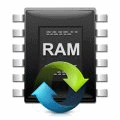
Most computer users with some form of knowledge quite like to keep their system running smoothly, and that includes cleaning out junk and old privacy files with tools like CCleaner to keep the hard drive clean from useless data. While looking around the root of your C drive, a couple of files you might come across which will be quite big in size are hiberfil.sys and pagefile.sys. You won’t be able to see them without showing hidden files in Windows folder options first, using a file manager or typing “C:” into the address bar to show hidden files in a web browser.
The size of these files actually will depend entirely on the amount of physical memory (RAM) there is in your computer because they are set automatically by Windows according to how much you have. If you use a large capacity hard drive for your Windows partition this won’t be a problem. But if you have an SSD or a smaller hard drive, this can become an issue when space is at a premium and these files are consuming several Gigabytes between them taking up a large percentage of available space.
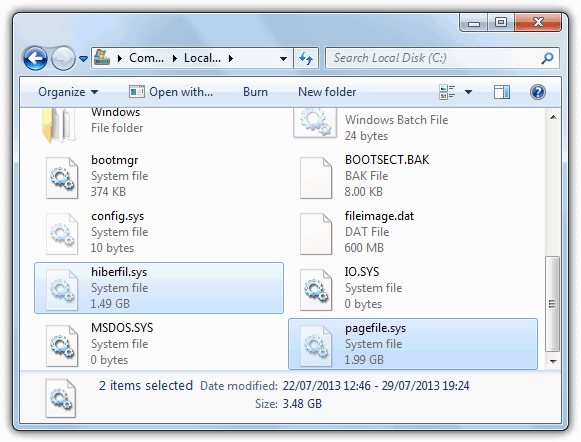
So, just what are the hiberfil.sys and pagefile.sys files and how can I remove them from my system? How safe is it to delete hiberfil.sys and pagefile.sys?
Here are the answers to the questions above.
The Hibernation File (Hiberfil.sys)
Hiberfil.sys is a file the system creates for the computer to enter hibernation mode. Hibernation copies everything stored in the computer’s memory and writes it to your hard drive in the form of the hiberfil.sys file. That’s the reason why the computer is quicker when waking up from hibernation than a standard Windows boot because the computer is only loading this file back into memory. Some of you will know this is partly how Windows 8 can manage to boot faster than Windows 7 and Vista because it uses hibernate to do so.
If you have 2GB of memory, then hiberfil.sys will be around 2GB in size, big enough to copy the current contents of memory to the file. Even if you don’t intend to use the hibernation feature, hiberfil.sys will still take up this huge amount of disk space and you cannot move it to another drive, not ideal if you have a small drive or SSD and a large amount of memory. Hibernation is enabled by default in Windows and if you don’t intend to use this feature, you may as well switch it off to free up the drive space.
Turn off Hibernation in Windows XP
Hibernation can easily be disabled in windows XP and it’s simply a single option accessible through the Control Panel.
1. Go to Control Panel and run Power Options. Or right click on the Desktop and go to Properties -> Screen Saver tab -> Power.
2. Click on the Hibernate tab and uncheck “Enable hibernation“.
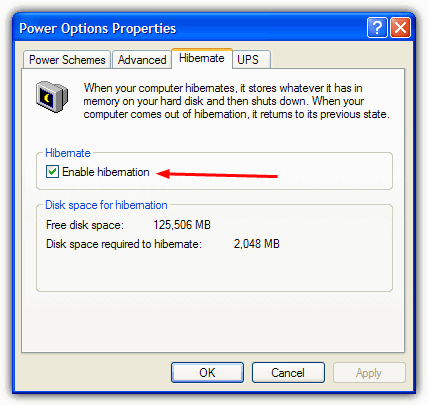
The hiberfil.sys file will be automatically deleted after you press OK and you’ll get back whatever hard drive space it was consuming. It will tell you how much Disk space will be saved in the window as you can see above.
Turn off Hibernation in Windows Vista, 7 and Windows 8
The hibernate feature in windows Vista and above is slightly more difficult to get at because you can’t delete it through the Power options in Control Panel. It can easily be removed however, by using one of the two methods below:
The easiest way is to download and run a Microsoft Fix It tool which has been developed just for enabling or disabling hibernation. Simply download and run the tool and depending on which one you use, the hiberfil.sys will be either created or deleted from the C drive.
Microsoft Disable Hibernation Fix It | Microsoft Enable Hibernation Fix It
The other option is to use Windows Command Prompt.
1. Open a Command Prompt with administrator privileges by clicking on Start and typing “cmd” into search. Then hold Ctrl+Shift and press Enter.
2. Type the following:
Powercfg -h off
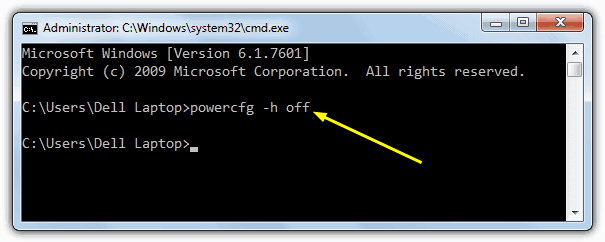
This will immediately disable hibernate and the hiberfil.sys will be deleted. To reverse the procedure, use “powercfg -h on”.
Changing the Size of Hiberfil.sys
By using the same Powercfg command above we can also reduce the size of the hiberfil.sys so it doesn’t automatically set itself to the same size as the amount of installed memory. Use the following command:
Powercfg -h -size {percentage number 50 – 100}
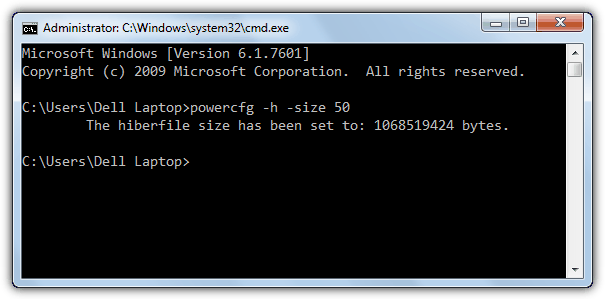
Setting the percentage to the lowest allowable of 50 will set the hiberfil.sys to half that of your installed memory, 75 to three quarters etc. Do be aware that this does come with its own issues because if you have more memory currently in use than the hiberfil.sys has been allocated, data loss and system problems will occur coming out of hibernate because it hasn’t saved the whole contents from RAM.
On Page 2 we show the solutions for dealing with the Pagefile.sys file.





User forum
53 messages